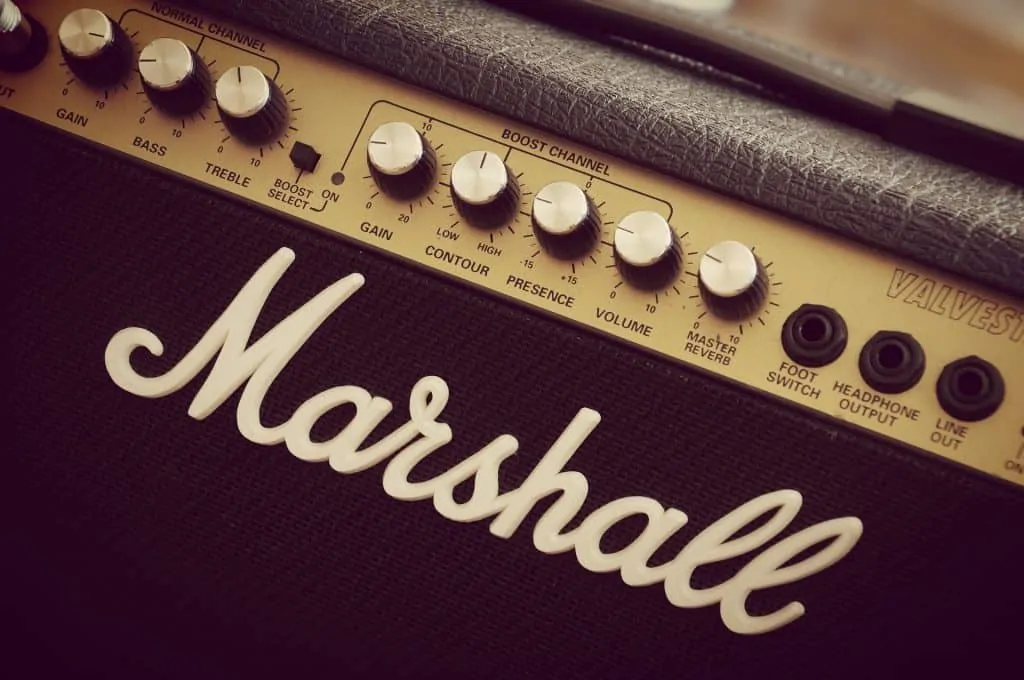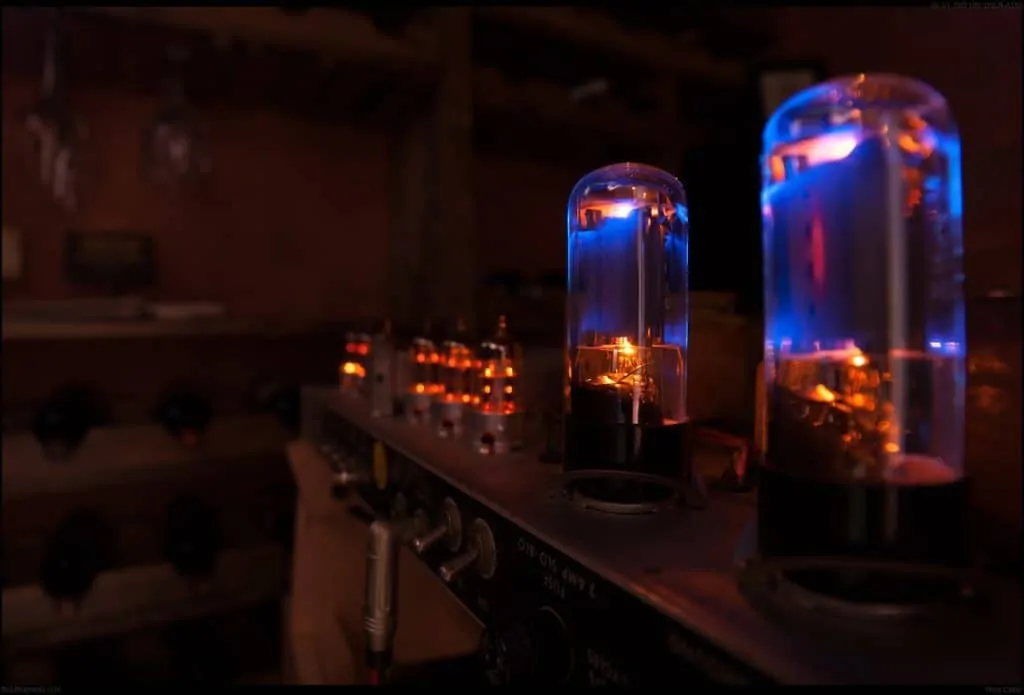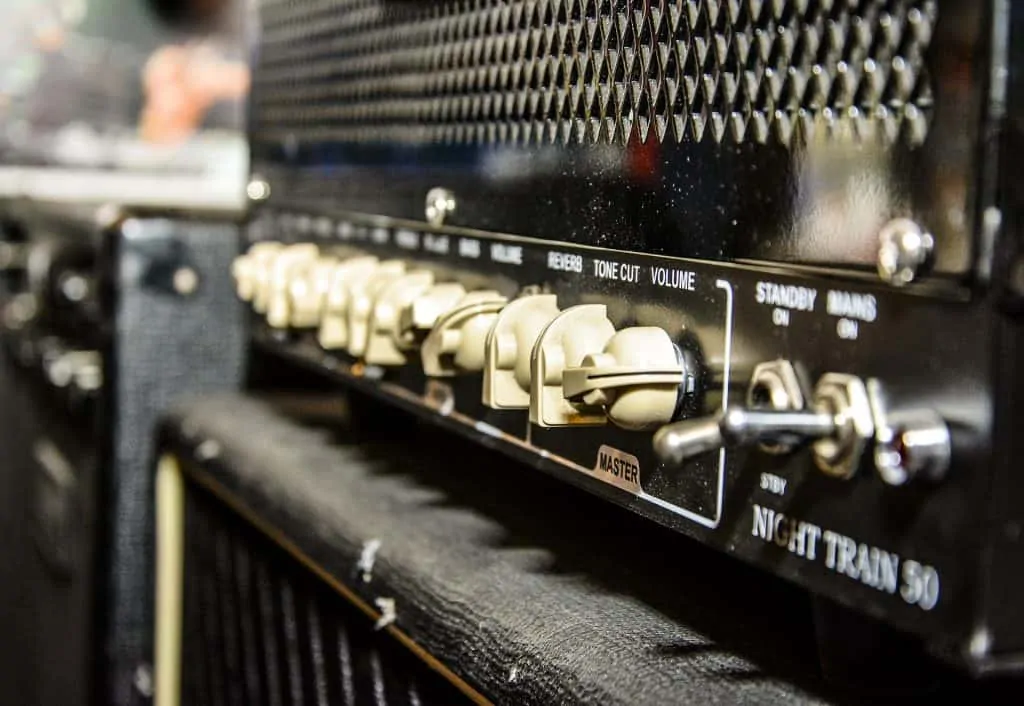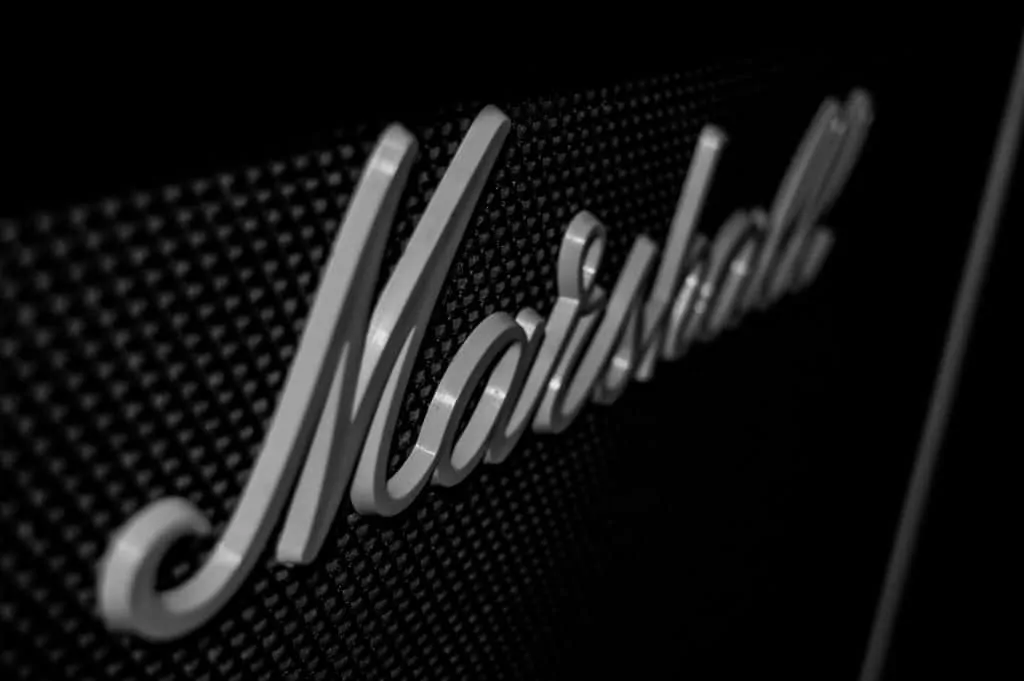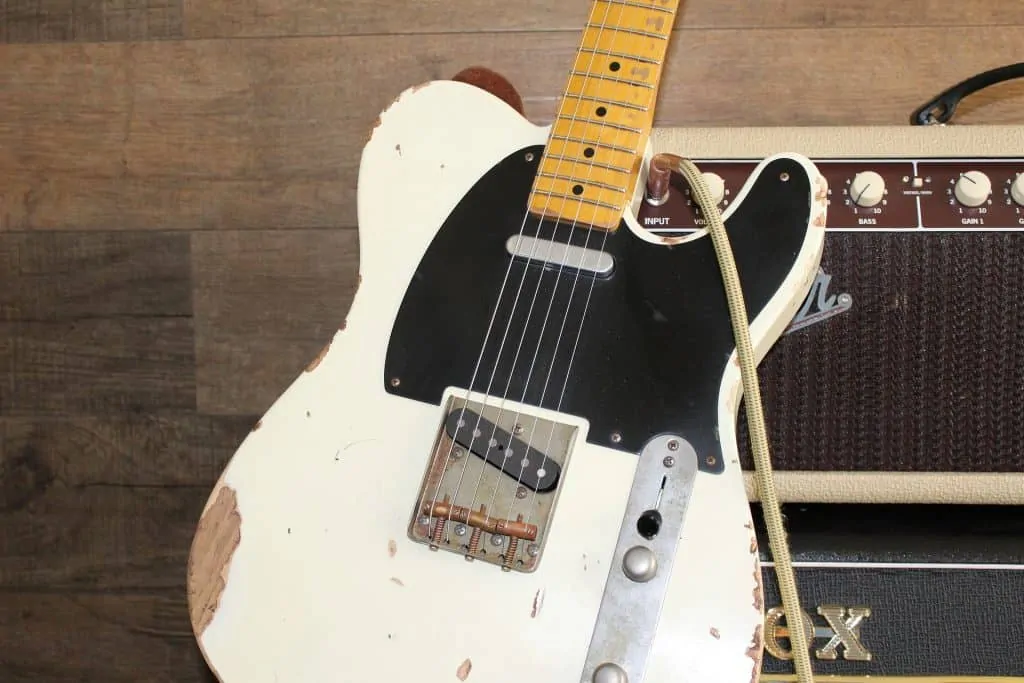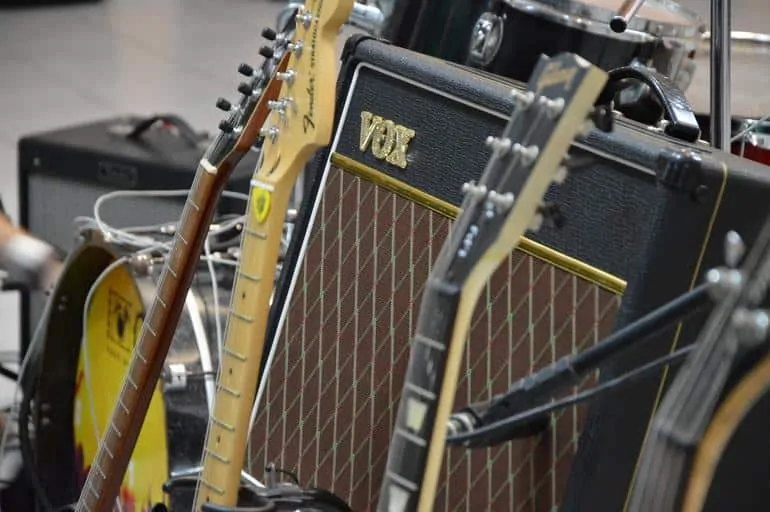I’m here to help you pick something amazing we call tubular amplifier, valve tube amplifier, or vacuum tube amplifier. Let’s just make it simpler and call them tube amps for electric guitars.
A tube amplifier is an electronic amp that uses vacuum tubes to increase the signal’s power. We’ll be looking more into that later on, for now, consider tube amps were replaced by solid-state amps in the 60s. The reason was these pieces were easier to build, cheaper, and easier to sell.
During the last decade, though, tube amps have been making a comeback. Why? Well, solid-state amps are transistor type amplifiers, so when they alter the sound they make it worse. On the contrary, pricier tube amps make the music sound better. Way better.
Let’s dive right into it and help you pick one for you. In the meantime, I can help you decide your first electric guitar with my last guide for the site about the best beginner electric guitars.
Contents
Are we talking budget or not?
Tube amps are expensive, quality gear, so, really, we’re not talking budget. Instead, we’re talking about the best, so I trust you’re here because you’re aiming to invest some of your effort into your gear.
These amplifiers are usually more advanced and sound better than your normal solid amp. However, if you’re only interested in a tube amp for practicing at home or rehearsing with your band instead of using it to play live, I will also guide you towards smaller, more affordable pieces.
Furthermore, if you’re a beginner guitar player, I’ll share with you the best tube amp for a beginner. It means I’m guiding you to an amp with fewer choices, easier sound customization, and more automatic features so you don’t go crazy with the knobs.
So, overall, small tube amps go for low two-zero budgets, although they are only good for playing at home. On the other hand, bigger tube amps, those you pick if you’re building a top-quality guitar gear, have triple zero budgets.
Let’s move on.
We’re looking at the best kind of amps, so we’re also aiming for the best.
Following this guide, you will learn:
- A brief history of tube amps, where do they come from?
- Why should you pick a valve tube amp?;
- What to look for in tube amps?;
- The top 5 electric guitar tube amps;
- The top 5 budget tube amps (also for beginners);
- The top 3 hybrid amps;
- Final Considerations.
In the meantime, here’s how a tube amp sounds:
Where do tube amps come from come from?
I promise you: reading this section will help you decide between a solid-state amp or a valve tube amp. Go on!
Vacuum amplifiers offer a vintage sound that’s hard to imitate. These exist since the beginning of rock music, and guitar players have always loved the sound of tube amps.
After the introduction of cheaper solid-state amplifiers, tube amps remained as the preferred option over their successor for one reason: the tone. The natural, warm, colorful tone that keeps the guitar’s original natural sound.
According to Pro Audio Land, the electric guitar amplifier came when enough progress had been made regarding the components and technology needed to create an amp.
By 1930, the basic principles of electricity discovered the movement of metal could cause a disturbance that could transform into an electric current using coils of wire.
By then, the world was already seeing big bands, and guitar players were in dire need of making their instruments louder. Guitar players were using acoustic guitars, which are completely drawn below the other musicians.
Early guitar players used microphones to amplify their sound.
The solution came with the pickup, manufactured by Hawaiian steel-guitar player George Beauchamp in 1942. Along with Adolph Rickenbacker, he created the Electro String Company by 1930, and after years of trial and error, they developed the first guitar pickup.
Before pickups, though, musicians resorted to using microphones to amplify acoustic guitars. In that regard, you can check our guide about the best microphones to record an acoustic guitar.
The creators also knew they would need an additional method to amplify the guitar, an output source that would translate the pickup’s signal into a sound people could hear. So, as a result, they were also developing the guitar amplifier during the 30s decade.
They did it by modifying existing P.A. amplifiers and Hi-Fi radios so they could understand the pickups’ signal. More so, they introduced a new technology, electrolytic capacitors, and rectifier tubes.
This technology allowed the production of affordable built-in power supplies musicians could plug into wall sockets, instead of using batteries. Keep in mind early battery packs were really big and heavy.
Van Nest for the Electro String Company in Los Angeles built the first valve tube amp by the late 30s. In time, Leo Fender, who had his shop in California, also started building guitar amps.
Early amps were, essentially, 10-watt speakers. However, as electric guitar popularity went up, also did the did for louder amps. So, in 1949, Leo Fender and engineer Don Randall built the first 50-watt amplifier with 12” speakers.
In wasn’t until the 60s when guitar players found out about distortion. In essence, by pushing the settings of an amp beyond what it can properly translate, they found the overdriven sound that would define the rock & roll era. So, as rock became popular, there came a demand for amps better designed to handle the high-gain output: louder, bigger, and meaner amps.
Musician Peter Townsend then asked Jim Marshall, a music shop owner, and friend, to introduce such amplifier. Given the opportunity, Marshall produced and sold the first 100-watt amplifier in 1965, which was connected to a stack of four 12” speakers made with high gain output in mind.
Marshall’s 100-watt amp was also the first solid amplification. Up to this point, all amps were using vacuum tube technologies, and even though musicians loved the warmth of its, tone, it didn’t come without some flaws.
For instance, the tubes needed to be frequently replaced as they burn out completely over time. Besides, tube amps were not designed for distorted sounds.
So, by the 70s, tube amps were replaced by much cheaper solid-state amps, which offer a more stable sound and distortion options.
However, you can find both kinds of amps today, as well as ones using tube preamps plus a solid-state power amplifier, which offers a good mix of advantages both options deliver.
You can see the valves at the top of the amplifier. Valves may go on the top or within the body of the amplifier.
Why should you pick a valve tube amp?
Both tube and solid-state amps work towards a single goal: take your guitar’s pickup signal into the speakers and transform it into a sound people can hear.
Even when the result is the same, we must discuss how it’s done, as understanding such fact will help you decide which kind of amp, and why, is good for you.
It’s time to focus on the key aspects of a tube amplifier, as well as the key aspects of a solid-state amp, as well as their advantages and disadvantages.
It’ll all be new for you. You can be forgiven for not knowing anything about tube amps, as its an outdated, old technology that’d not commonly found in music shops.
Breaking into this section let’s answer some questions for you, as I understand you may have not heard about tube amps before.
What is a valve tube amp and how does it works?
A valve amplifier is an electronic amplifier that uses vacuum tubes in order to amplify the signal’s power.
Tube amps are built of something engineers call “valves.” A valve, or vacuum tube, follow the same principle as Tomas Edison’s light bulbs.
In essence, valves control electrical currents going through a vacuum within a sealed glass tube.
Just like light bulbs, the filament inside glows when it gets hot, and the electrons are freed into the sealed tube. There’s a second electrode within the vacuum. Furthermore, an electric guitar valve has an additional electrode sitting between the other two to translate the electrical current into a signal the speakers can use.
How does a Tube Amp Work vs. How a Solid-State Amp Works
Solid-state amps and tube amps are very different, both in design and sound. Once you accept this, you’ll be on your way to understanding the traits and restraints they offer.
A vacuum tube amp drives its current through voltage. However, voltage isn’t enough to drive the signal into the speaker, so it needs the output transformers.
Most stereo tube amps (you can identify them because they have two speakers) have 3 large and heavy objects commonly at the rear. These transformers turn the voltage from the output tubes into the current for the speakers.
A solid-state amp is much simpler. It has a single power transformer whereas no output transformers. Additionally, the current runs through silicon cables. In other words, solid-state transistors are in place instead of valve tubes.
Once you accept the fact tube amps and solid-state amps are different, you’re on your way to understanding the traits and restraints of each one.
Hybrid electric guitar amps
A hybrid amp means it has a preamp stage which uses vacuum tubes. Later on, in the tuner circuitry, it uses solid-state transistors
Other hybrid amps offer a tube emulation circuity or preamps with advanced electronics that are designed to emulate vacuum tubes. Nevertheless, these modulators don’t sound like tube amps, rather, they sound like specific tube amps.
Amongst these specimens, we can find the Line 6’s Spider, a very versatile and exciting electric guitar amp.
Hybrid amps are closer to a tube amp in terms of tone and sell for cheaper prices. These electronics also don’t need tube replacement, so they are both less affordable at shipping and operation. However, ultimately, solid-state amps will always be cheaper and more reliable.
The Marshall electric guitar amp brand is famed for their hybrid amps modulating valve tube electronics.
So, all in all, why do people pick a valve tube amp?
Picking a valve tube amp
Making it simpler for you, here’s the list of reasons as to why picking a valve tube amp:
- A warmer, better sound:
Many players feel tube amps have the best tone as they have a warmer and more musical clean and distorted sounds.
In fact, the tone is the sole reason why these “outdated” amps still exist. It’s because they offer a more musical distorted and clean sound than the vast majority of solid-state amps.
Many professional guitarists praise the signing tone these electronics produce. The tone enhances low-frequency harmonics and introduces a mild, compressed distortion. It creates what I call a “cleaner” distorted sound.
- A “cleaner” distortion
A “cleaner” distortion means that using the right amounts of gain, the amp can still play clean sounds when you play the guitar softly, whereas it breaks into distortion when played stronger. It’s a dynamic behavior other kinds of amps can’t offer, which turn valve amps into an extension of your guitar playing.
Furthermore, it means the distorted tones are much more understandable than what you can find on a solid-state guitar. In turn, the guitar gains more presence within a band or a record.
When you drive the valve even harder upwards an overdriven sound, the distortion is less even that what a solid-state amp can offer. This kind of response is why valve tubes are louder than their solid equivalents.
- A better, louder and more powerful overdriven sound
Tube amps also offer an amazing overdriven sound. No matter how small they are, you can always saturate these electronics and get plenty of power. In fact, as tube amps often have lower voltage than solid-state amps and are usually smaller, these pieces maintain much higher sound fidelity than a solid-state amp putting the guitar’s sound into more gain than its natural sound can handle.
The Musician’s Friend site explains bigger is not always better: a 60-watts amp might blow your audience’s ears out the door, but a 20W amp going through a P.A. system might give you the exact saturated tone you’re looking for without sound-killing decibels. Many professionals prefer this approach for both playing live and recording music.
In fact, you get the most of a tube amp when the gain is nearly saturated, so it creates the revered overdriven sound the vacuum tubes can offer. FOr that reason alone, you’d be better off with a smaller (lower wattage) amp over a behemoth.
Fender specialists explain that, with a good tube amp, you can play with the guitar’s volume up to eleven and still get an incredible rock distortion. And by simply rolling back the guitar’s knob you can clean up the sound.
However, there are solid-state guitars which can compete against tube amps in this area, such as the Fender’s Mustang GT Series.
The Fender Mustang amp series is revered for its modulating features.
Tube amps have drawbacks too, you know, or else every professional musician would pick these electronics over solid-state amps. Let’s review them:
Valve tube amps drawbacks
Valve amps are indeed very good and still, solid-state amps are the industry standard. Especially for non-professional musicians.
So, there’s the question: why aren’t they more popular?
The answer boils down to two simple things: these are heavier and very expensive. So, for a beginner performer, lighter, cheaper gear is, more often than not, better.
Another major issue is the need to change the valve tubes. You’ll be changing the tubes and doing maintenance to power amps every 6 months. It might add to the hassle of already heavy and expensive gear.
Instead, you can have the best of both worlds with a hybrid amp or a modeling amp. A non-valve amp can still give a great variety of different tones, mostly coming from Marshal and Fender. However, a tube amp gives one single tone, which might represent a bad thing for certain players.
When should I buy a tube amp?
When you feel inclined to have the best tone, the most lively feel, and the most dynamic play style, consider buying a tube amp. More so, tube amps are particularly interesting and exciting when you’re into traditional rock music.
Besides, tube amps have an amazing response to chords and pick notes, so, if this fits your musical style, tube amps might be the best option for you.
Otherwise, you may gravitate towards a solid-state amp if your musical style ranges from heavy metal to pop or, more so, if you mix musical styles and need a variety of tones coming from your amp, in case you don’t have pedals. As for pedals, here’s our guide to low cost drive pedals.
As tube amps are all about that vintage sound, there’s a high chance you might not be interested in that sort of things if you’re a modern guitar player, probably more concerned about power, versatility, and experimentation.
What to look for in a tube amp?
Here’s everything you should know before buying a tube amp. Feel free to go straight to the next section if you are already a connoisseur.
Take note of the following things:
1. Electric guitar amp categories
Reviewing amp classes is important, so let’s dive in:
- Solid-state amps (analog): these amps use transistors for their power and preamp sections. They are reliable and seldom need any repairs. They offer a clean tone and come with a distortion switch for chainsaw music. These are the cheapest and more practical of the four kinds
- Tube amps: these are the preferred option of most pro guitar players for their warm, powerful, lively tone and dynamic distortion. THese are louder than solid-state amps and gives the music a definite vintage feeling other amps simply do not. Heads, up, one of my favorite musicians, Foo Fighters’ Dave Grohl, uses a Vox AC30, a vacuum tube amp.
- Modeling amps (digital amps): these use digital processors to simulate valve tube tones. The software “models” the sound, so these amps can put various tube amps in a single box. You can program modeling amps and have built-in digital effects like chorus, delay, or reverb. Some include analog or digital outputs with speaker simulations you can use for going direct into a PA system or interface.
- Hybrid amps: these combine the best of both worlds into a single amp, as they use tubes as a preamp system plus a solid-state power section for the amp system.
2.Configuration
Amps comp in two distinct configurations: combos, which include the speakers and the knobs in a single cabinet; or a ship with the cabinet and the head separately. So, which one is best for you?
The answer depends on where you’re hoping to play. Is it a big venue? Is it a small bar? Is it the rehearsal studio? Is it for recording? Or just playing at home?
So, for small halls, clubs, and bats, you’ll be well equipped with an amp combo, which gives more than enough power for this kind of venue. Consider going for a 50 or 60W amp for these cases.
If you’re looking to fill an auditorium with guitar firepower, or even an arena, get a high-powered cabinet stack with 4 12” speakers and a 100-watt head.
If you’re looking to play with a tube amp in a big area, you’ll have to put a mic into the amp and run it into a PA system that can handle it.
The two-unit configuration means each piece, on its own, is lighter and easier to carry than a combo. Also, remember combining two different cabinets with a single head is known as a “stack.”
Most guitar players prefer using a tube amp going through a quality PA system.
3. Does the size of the speakers matter?
Let’s be clear and say by “cabinet” I also mean speaker. Different speaker sizes produce different sounds, so yes. A smaller speaker often produces higher frequencies than bigger speakers. Thus, small speakers are high on treble and are called tweeters, while large speakers boost bass frequencies and are called woofers.
Different speaker sizes produce different sounds, so yes. A smaller speaker often produces higher frequencies than bigger speakers. Thus, small speakers are high on the treble and are called tweeters, while large speakers boost bass numbers and are called woofers.
It means a 10” speakers produce a better quality sound than a 15” or 17” speaker. So, again, bigger is not always better. It might be louder, but will you or anyone else be able to understand the guitar’s sound on a louder speaker?
Keep in mind good practice amps are usually solid-state combos going from 10 to 30Watts with small 8 to 10” speakers.
For playing live in small venues, you need to look for a power outage of 50 Watts with 4×12” cabinets for a full sound.
And, finally, for large venues, search for 100 watts above. You can even use a stack. Keep in mind a 100-watt amp doesn’t sound twice as loud as a 50-watt. The difference comes down to about 3 dB.
As for tube amps, 10watts is more than enough for playing alone; while 30 to 60Watts is enough for everything else.
Where do you intend to play with your amp? The answer will let you know the size of the speakers you need.
4. Cabinet design
Another thing to consider is the difference between a closed-cabinet design vs. an open-backed cabinet design. Both offer a different sound, even if they have the same characteristics and feature the same speakers.
DO you know what I’m talking about? Well, check any electric guitar amp on the back. DO they have a hole where you can see the speakers and the wiring? Then that’s an open-backed cabinet.
Open-backed cabinets have a wider range of rock tones, which is why many traditional rock players prefer this kind of amps.
On the contrary, if you’re looking for a big fat sound, you’ll likely prefer a closed-back cabinet and, more so, you’ll be best going for a 100-Watt head with a couple of 4×12” speakers, which is the most popular cabinet measure.
Keep in mind most cabinets are partially open as they have upper and lower panels covering half of the back.
Guitar site Celestion explains open cabinets can fill a room with a natural sound because a back panel compresses the speaker’s “voice.” On the contrary, open back cabinets offer a more organic sound, where high frequencies particularly benefit.
More so, open-backed cabinets provide excellent choices for recording regarding mic placement, as you can achieve a different tone placing the mic on the rear.
Now, closed cabinets can only project the sound forward, which means that, ultimately, they can have more power and enhance midrange and bass frequencies. However, as the sound doesn’t leak backward and to the sides, it’s harder to hear onstage unless you’re directly in front of the amp.
5. Construction
We must consider the construction materials of the amp as well. The thinner the wood, the more likely the speaker is to fall from its place. You need to look for thickness of at least 1/2”, which can achieve a strong sound and maintain the speaker on its place.
Additionally, consider buying an amp with corner protectors if you’re looking to move your amp from gig to gig.
6. Valve tubes quality
Another thing to consider is tube quality, which depends on the type of vacuum tubes you buy. Different types of power tubes offer different sounds.
- 6L6 power tubes have a nice and clear sound with a lot of punch.
- An EL34 tube has tight lows, clear mid-range tones, and bright highs.
- An El84 tube as lower output and offers a smooth harmonic distortion.
- The 6V6 tube also offers a smooth distortion with a bluesy tone and rich low-frequency tones.
- The fat 6550 tubes and KT88 tubes have a clear sound full of bass and low-end frequencies.
7. The preamp
The preamp does most of the work regarding tonal shaping. We need to know about the preamp circuit quality and the features it has, such as effect loops, EQ, reverb, multiple channels, and more.
It’s common to find amps with one to four channels. However, amps with multiple channels offer more flexibility as guitar players can rely less on pedals for overdrive and other effects. Instead, they can rely on independent gain controls for each amp channel.
Most high gain amps feature two channels, which are clean and gain. The player may then turn up and down the preamp’s gain where need be and leave the master volume at a lower level. The lower the master level is, the more clear a distortion you can get.
However, keep in mind you won’t be able to tweak independent gain knobs as you play a song. You can only do this between songs, so pedals are still the best option to abruptly change the sound during a song.
Otherwise, remember tube amps allow you to play in an out distortion depending on how hard you strum the strings.
More so, players looking for tone purity may still prefer a single channel. It means you would always play on clean and depend on pedals for your distortions. Such way of playing maintains a higher sound fidelity than using the amp’s own distortion channels.
Also, keep in mind that when you see an amp with multiple effects such as buffers and reverb but still costs the same as a less complex amp, the maker probably cut corners somewhere.
So, yet again, less might actually be more: the main options you’re looking for are:
- A clean vs. distortion switch (optional);
- Master volume;
- Gain;
- Treble;
- Bass;
- Reverb (optional).
If you’re unsure about this, check the video below about electric guitar amps’ settings and options (the preamp).
8. Budget
Despite everything I said, the budget might be the deciding factor for you. And, as I said many times, tube amps are expensive and sell go for triple-zero pricers.
As I pointed out in my previous electric guitar buyer’s guide, you should always spend more money on your guitar than on your amplifier. It means don’t go crazy buying a super-expensive, top-tier quality tube amp if you don’t have the guitar to back that up.
To be clear: a higher price doesn’t always mean a better tone or a better quality. Some amps are just incredibly famous and revered, so you would be paying a buck for the brand you bring back home.
So, set your budget and see what may suit your needs. Don’t worry, though, because I will guide you towards the best of the best in the next section, as well as the best budget tube amps in the market right now.
A Fender Telecaster with P90 pickups is definitely a guitar that justifies buying a tube amp.
The top 5 valve tube amps
If you jumped straight to this section, feel free to check below for additional guidance. I also recommend you check the amps of your liking on YouTube before you buy.
Here are the top 5 valve tube electric guitar amps you can buy right now:
Vox AC30C2
Dean DeLeo, the guitar player for Stone Temple Pilots and Velvet Revolver; and Dave Grohl, Foo Fighters’ vocalist and guitar player, both vouch for this power amp.
You can see the whole Foo Fighters band playing their 2011 Wasting Light album on their Studio 66 using the Vox amplifiers on the video below:
Other great musicians, including U2’s Edge or Queen’s Brian May also use this power amp.
The Vox AC30 power amp sits comfortably on the 30-watt side, which means you’ll be able to play with your guitar’s volume up and play with the amp’s gain and volume knobs to get a nice and clean overdriven sound. All in all, it has an amazing crisp and mixes a vintage guitar with a classic rock distortion.
The amp is so popular it continues to thrive in today’s world. Usually, it ships as a combo with 2X12” speakers with an open-back cabinet. It’s also rather lightweight and sturdy enough to survive traveling from gig to gig.
The speakers deliver warm low frequencies, a smooth mid-range, and crisp high-tones.
Vox amplifiers are always a great choice. It’s a top guitar-amplifier brand.
The Vox features a “Tone Cut” knob, which is a Vox-owned EQ knob. In particular, this Tone CUt sits in the power section instead of the preamp section, which means it allows a more precise tone control.
As for preamp, it has treble, middle, and low knobs. Additionally, the AC30 packs two built-in top-quality effects: reverb and tremolo. You can get a great response with an extra footswitch.
More so, the amp gives individual control knobs for each channel, plus a master volume control. See, most tube amps are meant to be played with the high volume and gain levels as it gives a warm, lively sound.
So, with these features, you can play around with the volume controls and always keep your sound in check: by placing the channel volume knobs on the preamp section, you can turn the volume down, keep master level up, and thus avoid messing with the guitar’s tone.
Remember this simple fact: turning the master volume up and down changes the guitar sound. The higher it is, the more distorted, powerful or crunchy it sounds; the lower it is, the softer and more mellow the guitar sounds.
Marshall Handwired 1974X
I want to be honest here. There’re plenty of Marshall Handwired guitar amps I would have liked to get on this list. The thing is most of them are already discontinued or hard to find and buy.
For example, I could mention the Marshal 1954X amp, favorited by Stone Temple Pilots’ Dean De Leo and Ozzy Osbourne’s guitarist Zack Wilde. However, you wouldn’t be able to find that one right now, so, instead, we will check out the Marshall Handwired 1974X.
Marshall manufactured the “Handwired” amps from 1966 to 1968. The 1974 model means the model’s number, not the year of creation.
It’s an 18-watt 1X12” combo amp with a tremolo built-in effect. It’s, by all means, Marshall’s holy grail of tube amps, which provided an aggressive growl rock sound with warm mid-range frequencies.
Over the years, the world ran out of these marvels, and the original combos send for thousands of dollars today if you’re ever able to find one.
So, Marshall created the 1974X model and added it to its acclaimed Handwired series. The modern reissue maintains the same qualities: 1X12” combo amp with a tremolo built-in effect and included tremolo.
More so, it includes the same EL84 tubes plus and a EZ81 rectifier tube. As for the speakers, we’re talking about the same speaker brand the Vox above has, Celestion.
If you’re looking for additional volume, Marshall also sells a 1974X 1X12” cabinet extension for the same price.
This Marshall is probably the best amp out there regarding sound fidelity. So, if you’re in love with the sound of your guitar, search for the 1974X or similar Marshall tube amps (like the budget alternatives I’ll share on the next section).
As for preamp and just like the Vox, it has treble, middle and low knobs, a volume control, and a master volume knob.
On a side note, playing this amp with a guitar packed with dual-humbuckers will give you a crunchy, rock sound. You can learn more about guitar pickups in this guide.
Keep in mind that Marshall’s tube amps are so popular they have become Muse’s Matt Bellamy’s favorite guitar gear.
Supro 1695T Black Magick
Led Zeppelin’s Jimmy Page used his own signature guitar amplifier, the Sundragon. It was made by a Vox and Marshall engineer, Mitch Colby.
So, although the Sundragon is something you will never have, his Supra tubular amp is the epitome vintage tube amps and comes really close to Page’s original, branded sound.
he Black Magick is a 25-watt combo amp with a 1×12” speaker.
It has two channels: one for tone control and one with a tube-driven tremolo effect which, however, doesn’t pack a footswitch.
Fender ‘65 Deluxe Reverb Vintage Reissue
We couldn’t continue this top 5 without including a Fender amp. This mid-sized Deluxe Reverb amp is one of the favorite electric guitar power amps by many tourist artists since it arrived in the ’60s.
It has blues and rockabilly origins, which is why it delivers a rich tone that fits many styles other than classic rock genres.
This particular vintage redesign is a lightweight 22-watt amp built for the road. It as a 12” Jensen speaker with a solid Birch strong wood, an open-ended cabinet and a total weight of 42lbs.
It has an all-clean sound that goes all the way up to vintage overdrive. Plus, it has a whole array of tones you can choose from.
The reissue includes the powerful 6C6 power tubes plus a 12AX7 preamp tube. It also has two channels, one for normal and the other with a vibrato configuration. The secondary channel features vibrato and reverb effects plus a two-button footswitch to turn these effects on and off.
Overall, is the most versatile tube amp of the list, so keep that in mind.
Orange CS50 Custom Shop (head)
Closing up the list, we bring you a no-nonsense hand-wired amp. The cream of reputed musical brand Orange.
The CS50 is a premium head amp delivering the highest standards for modern guitar players.
It’s rather simple: it features a single channel, four valves, and supports 50-watts. Its combination of gain, its interactive tone section, its 3-band EQ, and its HF Drive controls can give you an ocean on beautiful tones and sounds.
It’s also very simple to use as it has no effects, no loop, no reverb. However, it’s an incredible creator of guitar tones.
Remember, you would need to buy an extra cabinet for this piece, and I recommend you search for orange cabinets. In particular, search for tube cabinets with Celestion speakers liek this one.
You can also check this option from orange, which gives additional effects and features for a similar price and with a similar sound.
The top 5 budget valve tube amps
Here are some more affordable options if money is indeed a problem. The top 5 budget valve tube electric guitar amps you can buy right now are:
California Tone Research Set5
It’s a low-priced 5W electric guitar tube amp. It has a 12AX7 preamp plus an EL84 power tube, so it delivers pure tones on its 8” speaker.
It has one output with volume levels, bass controls, a treble controls. Additionally, it features two 1/4” outputs for 8 or 16 ohms speakers.
Alas, its simplicity is its major attraction.
Fender Pro Junior IV
This amp is part of the Fender Hot Rod series and delivers the unique Fender classical rock sound.
It’s an affordable small tube amp with a reliable sound, which is surprisingly loud for its 10” speaker.
Besides, it’s easy to tone, customize and use with just tone and volume controls. And even so it’s a budget alternative, the tubes still offer the touch-sensitive authentic tubular sound (I’m talking about the dynamic distortion).
Marshall 2525C Mini Silver Jubilee
This amazing mini version of the popular Silver Jubilee tube amp packs Marshall’s signature tubular sound.
The Silver Jubilee line celebrates 50 years of Jim Marshall working for the music industry. It contains a 3-band EQ, presence, gain, and volume FX loop controls.
It packs the highest Marshall factory standards and has no outsourced parts.
Monoprice 611705
This Amazon Choice is an incredible budget 5-Watt tube amplifier with an 8”Celestion speaker.
It’s a versatile amp for any guitar and any style, it’s durable and reliable and delivers a rich, beautiful sound.
It uses 12AX7 tubes for its preamplification and 6V6 tubes for the power part. It delivers powerful low frequencies and provides high-frequencies rich in harmonics. It means it would be very good for practicing, rehearsing and even recording amateur hard rock, metal, or similar music.
The amp includes low and high inputs.
Vox AC4
This is nothing but the Vox AC30 budget version. The AC4 is a limited edition 4-Watt miniature tube combo amp.
Still, it delivers the same epic, rich, and powerful tones of the revered Vox tubular amps many guitarists prefer.
it has two 12AX7 preamp tubes plus an EL84 power tube. More so, it packs bass and treble knobs helping you control the 12” Celestion speaker.
This might be small, but it’s an A-class tube amp which gives pristine clean-sounds and loud crunches.
Final Considerations
As always, thank you for reading this guide on how to choose the best tube amp, I hope it guided you towards the outcome you want.
And, as usual, it’s all about your personal preferences. Search what suits you best.

